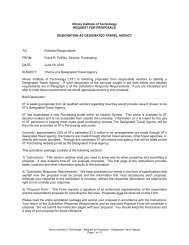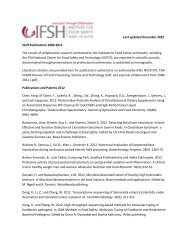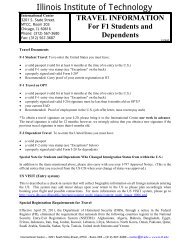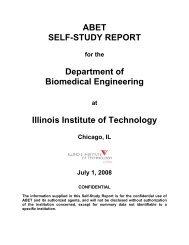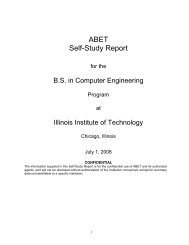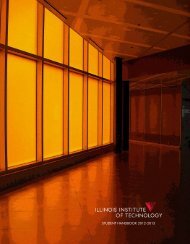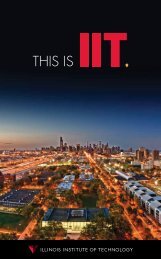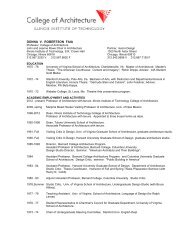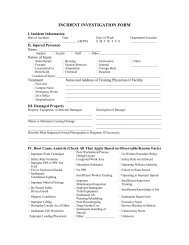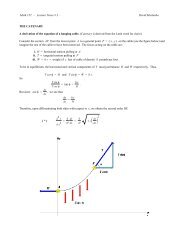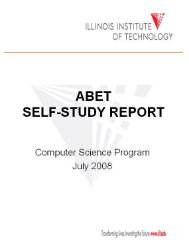Copyright & Disclaimer Information - Illinois Institute of Technology
Copyright & Disclaimer Information - Illinois Institute of Technology
Copyright & Disclaimer Information - Illinois Institute of Technology
Create successful ePaper yourself
Turn your PDF publications into a flip-book with our unique Google optimized e-Paper software.
154<br />
Course Descriptions<br />
Biomedical Engineering<br />
BME 100<br />
Introduction to the Pr<strong>of</strong>ession<br />
Introduces the student to the scope<br />
<strong>of</strong> the biomedical engineering pr<strong>of</strong>ession<br />
and its role in society and develops<br />
a sense <strong>of</strong> pr<strong>of</strong>essionalism in the<br />
student. Provides an overview <strong>of</strong> biomedical<br />
engineering through lectures,<br />
presentations by outside<br />
speakers, hands-on exercises and scientific<br />
literature analyses. Develops<br />
pr<strong>of</strong>essional communication and<br />
teamwork skills. (3-0-3) (C)<br />
BME 301<br />
Bio-Fluid Mechanics<br />
Basic properties <strong>of</strong> fluids in motion.<br />
Lagrangian and Eulerian viewpoints,<br />
material derivative, streamlines.<br />
Continuity, energy, angular and linear<br />
momentum equations in integral<br />
and differential forms. Applications<br />
in bi<strong>of</strong>luids and biomedical devices;<br />
Rheology <strong>of</strong> biological fluids.<br />
Prerequisites: BIOL 115, MATH 251,<br />
MMAE 200. (3-0-3)<br />
BME 308<br />
Reaction Kinetics for Biomedical Engineers<br />
Introduction to the fundamentals <strong>of</strong><br />
chemical kinetics. Analysis <strong>of</strong> rate<br />
data; single and multiple reaction<br />
schemes. Biomedical topics include:<br />
enzymatic pathways, biological systems,<br />
receptor-ligand kinetics, microbial<br />
cell growth and product formation<br />
and the design and analysis <strong>of</strong><br />
biological reactors. Prerequisites:<br />
CHE 202, MATH 252. Corequisite:<br />
BME 301. (3-0-3)<br />
BME 309<br />
Biomedical Imaging and Sensing<br />
An introduction to concepts <strong>of</strong> imaging<br />
and sensing that underlie a wide<br />
range <strong>of</strong> biomedical imaging modalities.<br />
Topics covered include cell imaging,<br />
multiphoton microscopy for biomedical<br />
studies, molecular imaging,<br />
infrared imaging, biomedical magnetic<br />
imaging, X-ray imaging,<br />
nuclear medicine, magnetic resonance<br />
imaging, and ultrasound imaging.<br />
Prerequisite: PHYS 221.<br />
Corequisite: BME 330. (3-0-3)<br />
<strong>Copyright</strong> & <strong>Disclaimer</strong> <strong>Information</strong>: <strong>Copyright</strong> © 1994, 1995, 1996, 1997, 1998, 1999, 2000, 2001, 2002, 2003, 2004, 2005, 2006, 2007. CollegeSource®, Inc. and Career Guidance Foundation. CollegeSource® digital catalogs are derivative works owned and copyrighted by CollegeSource®, Inc. and Career Guidance Foundation. Catalog content is owned and copyrighted by the appropriate school. While CollegeSource®, Inc. and Career Guidance Foundation provides information as a service to the public, copyright is retained on all digital catalogs.<br />
<strong>Copyright</strong> & <strong>Disclaimer</strong> <strong>Information</strong>: <strong>Copyright</strong> © 1994, 1995, 1996, 1997, 1998, 1999, 2000, 2001, 2002, 2003, 2004, 2005, 2006, 2007. CollegeSource®, Inc. and Career Guidance Foundation. CollegeSource® digital catalogs are derivative works owned and copyrighted by CollegeSource®, Inc. and Career Guidance Foundation. Catalog content is owned and copyrighted by the appropriate school. While CollegeSource®, Inc. and Career Guidance Foundation provides information as a service to the public, copyright is retained on all digital catalogs.<br />
BME 310<br />
Biomaterials<br />
Application <strong>of</strong> biomaterials in different<br />
tissue and organ systems.<br />
Relationship between physical and<br />
chemical structure <strong>of</strong> materials and<br />
biological system response. Choosing,<br />
fabricating and modifying materials<br />
for specific biomedical applications.<br />
Corequisite: CHEM 237. (3-0-3) (C)<br />
BME 315<br />
Instrumentation Laboratory<br />
Laboratory exercises stress instrumentation<br />
usage and data analysis<br />
used to determine physiological<br />
functions and variables and the<br />
relations to physiological variability.<br />
Prerequisite: ECE 211. Corequisite:<br />
BME 330. (1-3-2) (C)<br />
BME 320<br />
Fluids Laboratory<br />
Laboratory experiments in thermodynamics,<br />
biological fluid flow and heat<br />
transfer. Emphasis is placed on current<br />
methods, instrumentation and<br />
equipment used in biomedical engineering;<br />
oral presentation <strong>of</strong> results;<br />
and on the writing <strong>of</strong> comprehensive<br />
reports. Prerequisites: BME 315,<br />
BIOL 115. (0-3-1) (C)<br />
BME 330<br />
Analysis <strong>of</strong> Biosignals and Systems<br />
This course is a junior level introduction<br />
to the theoretical and practical<br />
aspects <strong>of</strong> signal processing and<br />
dynamic systems behavior as they<br />
relate to physiological, biological, and<br />
biomedical systems. The topics covered<br />
will include sampling theory,<br />
continuous and discrete Fourier<br />
transforms and series, Laplace transforms,<br />
Linear systems theory, signal<br />
filtering, models <strong>of</strong> biological and<br />
physiological systems, and analysis<br />
<strong>of</strong> dynamic and feedback systems.<br />
Prerequisites: BME 100, MATH 252,<br />
ECE 211. (3-0-3)<br />
BME 405<br />
Physiology Laboratory<br />
A laboratory course that demonstrates<br />
basic concepts <strong>of</strong> bioengineering<br />
design through experimental procedures<br />
involving humans and experimental<br />
animals. Statistical principles<br />
<strong>of</strong> experimental design. Study <strong>of</strong><br />
IIT Undergraduate Bulletin 2006–2008<br />
possible errors. Experiments include<br />
nerve action, electrocardiography,<br />
mechanics <strong>of</strong> muscle, membranes,<br />
and non-invasive diagnostics in<br />
humans. Prerequisite: BME 315.<br />
(0-3-1) (C)<br />
BME 410<br />
Transport Phenomena in Living Systems<br />
Convective and diffusive movement<br />
and reaction <strong>of</strong> molecules in biological<br />
systems. Kinetics <strong>of</strong> homogeneous<br />
and heterogeneous reactions in biological<br />
environments. Mechanisms<br />
and models <strong>of</strong> transport across membranes.<br />
Convective diffusion with<br />
and without chemical reaction.<br />
Prerequisites: BME 301, MATH 252.<br />
(3-0-3)<br />
BME 415<br />
Concepts <strong>of</strong> Neural Engineering<br />
Introduction to the fundamentals<br />
and principles <strong>of</strong> neural engineering.<br />
Emphasis is placed on pathological<br />
conditions that motivate the engineering<br />
design and clinical use <strong>of</strong><br />
neural prosthetic devices.<br />
Pacemakers, FES stimulators, as<br />
well as CNS devices are examined,<br />
including extacorporeal, and<br />
implantable systems. Prerequisites:<br />
ECE 312, BME 315. (3-0-3) (C)<br />
BME 419<br />
Design Concepts in Biomedical Engineering<br />
Introduction to Design Concepts in<br />
Biomedical Engineering. This course<br />
aims to educate students on project<br />
definition and on the design, development,<br />
and technology transfer <strong>of</strong><br />
potential biomedical products in the<br />
context <strong>of</strong> the student’s major capstone<br />
project. Students will learn<br />
best practices for designing a marketable<br />
medical device, including the<br />
design process from the clinical problem<br />
definition through prototype<br />
and clinical testing to market readiness.<br />
Prerequisite: Senior Standing.<br />
(1-0-1) (C)<br />
BME 420<br />
Design Concepts in Biomedical Engineering<br />
An introduction to the strategies and<br />
fundamental bioengineering design<br />
criteria behind the development <strong>of</strong><br />
biomedical engineering systems and<br />
implantable devices that use either



